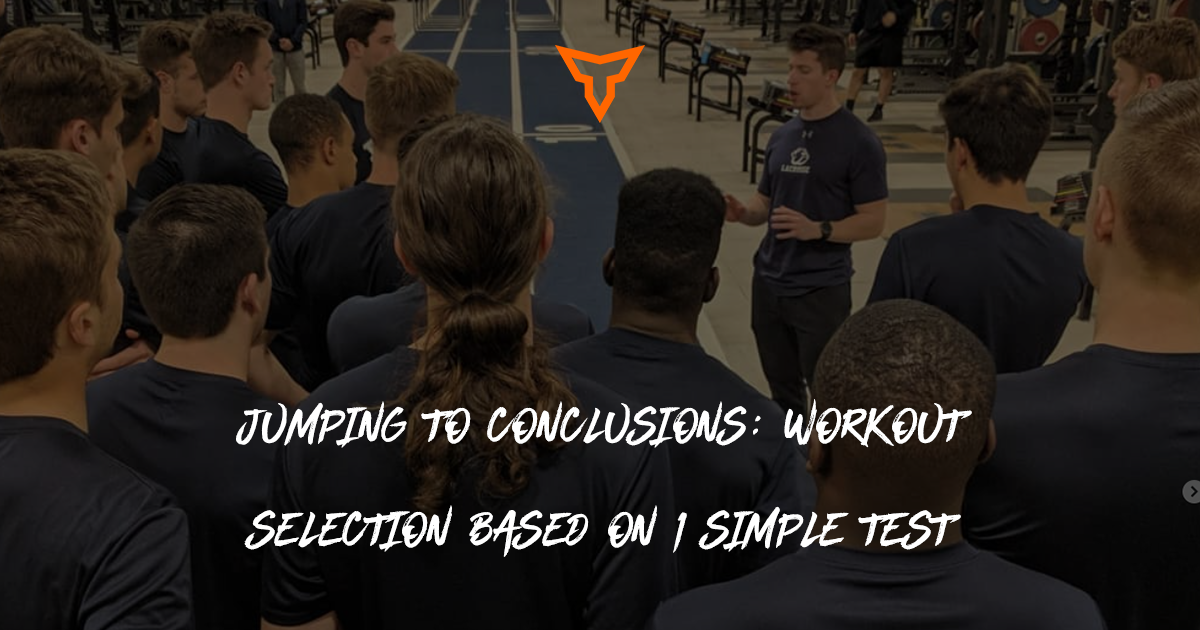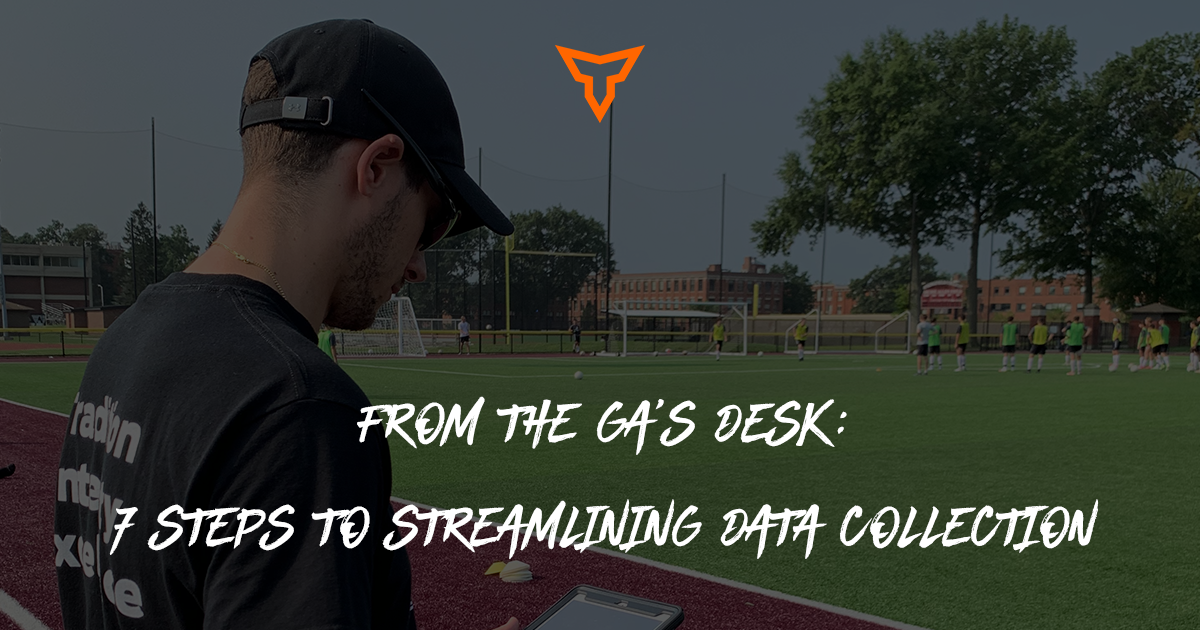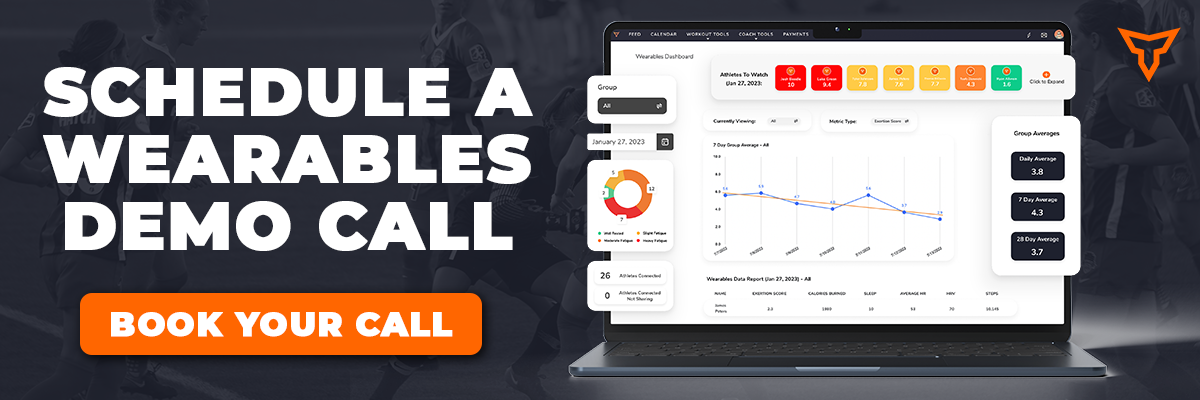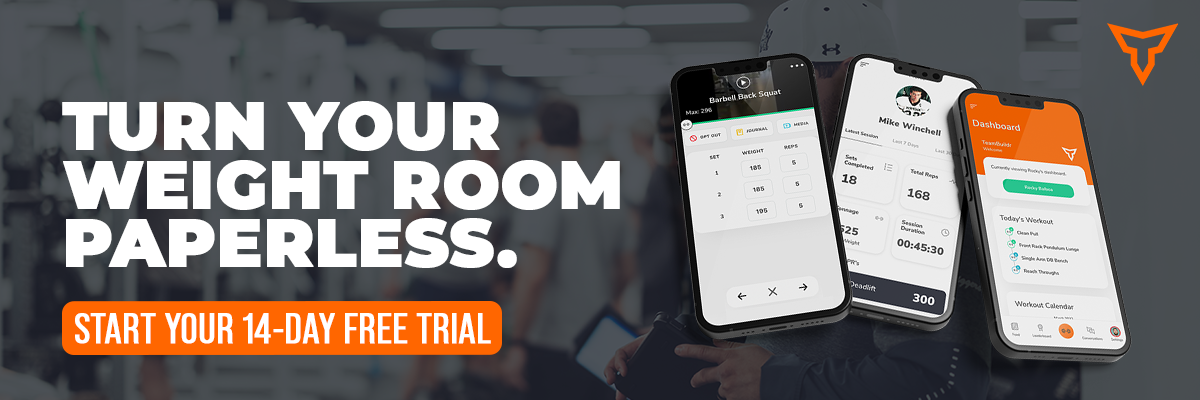Testing vs. Monitoring: A Guide to Practical Sport Science Assessments
I’ll be the first to admit that when it comes to the technological side of sport performance, I’m a relatively simple fellow. If I had to put a label on myself, I’d consider myself more of a technician than a sport scientist. I’d take being on the floor coaching my kids over being behind a laptop anyday.
That being said, there is a ton of value when it comes to the quantifiable metrics associated with sport performance. Let me rephrase that: there CAN be a ton of value when it comes to the quantifiable metrics associated with sport performance. Unfortunately, far too many strength coaches tend to collect data for the sake of collecting data; after all is said and done, the numbers become filed, the planning remains unchanged and the hours wasted seem to further accumulate. What’s worse, some coaches use the data found in the testing battery to punish the athletes, where it should simply be used to inform and optimize the training process.
The good news is that in recent years, data collection has become easier than ever. What’s more important is we better understand HOW to use the data for future planning and we better understand the interpretations of said information. It no longer is simply collecting information to check a box.
As I told y’all earlier, I’m no sport scientist. However, I do value data that can influence, reaffirm, or correct my programming to create better athletes. Being a relatively simple guy, my staff and I over at Iron Performance Center tend to keep the sport science aspect as simple and practical as possible. For those who may be scoffing or turning their nose up at the thought of implementing some of these concepts, realize that if you’ve ever tracked your athletes’ lifting numbers and week to week progress (every coach ever), you’ve already been performing sports science; we’re just taking it one level further. In the coming paragraphs, I’ll go over what metrics we value, how we evaluate them and what we do with the results. As always, feel free to disagree or disregard; this is just our way of doing things for the time being.
MONITORING
Our staff define monitoring as information collected daily with the intent of evaluating (whether qualitative or quantitative) our athlete’s state of readiness or ability to function. A few metrics we collect (almost) daily:
- Attendance
- Bodyweight (kg)
- Non-Counter Movement Jump (in)
- Counter Movement Jump (in)
- Vertical Jump (in)
- Isometric Mid-Thigh Pull (N)
Yes, some of these metrics can be used in our “testing” procedures as well. We’ll touch on that later. We should also note that the outcomes of these procedures doesn’t necessarily mean our training plan will change for the day.
In the interest of keeping this article useful to readers, I’ll briefly outline what equipment we use and the procedure we follow for collecting the above metrics. If your eyes are already glazing over, just scroll ahead to the TESTING section.
Attendance
Pretty straightforward stuff. They show up, we mark them as “here” on our Google spreadsheet. It’s literally just a monthly tab on sheets with the days of the month across the top and each team's roster along the y-axis rows. Super simple, super effective. Yes, coaching software does the same thing: use that if you have it.
Why is collecting attendance important? Well, it may seem obvious but we can’t help those who don’t actually show up. Remember, athletes can “athlete” without coaches, but coaches can’t coach without athletes. A monthly report can help keep athletes accountable and coaches in the loop, as well as provide context for those athletes who may not be seeing as much benefit from the training program (those who rarely show up). They may be able to help get the kids in the weight room.
My suggestion would be to have a relative attendance leaderboard. Let other teams see other teams showing up more. After all, we all love competition and if showing up is the low hanging fruit, even better. Plus, let’s face it. We can’t control the wins and losses; justifying our worth as a strength coach to our superiors can be a hairy situation if we hang our hat on KPIs we cannot have an influence on. Attendance is one of the easier ones to improve, get more kids in your room than last season and you’ll probably do better as a coach this season.
Bodyweight
We have our kids just step on a scale near the front of the room once they’re all changed and ready to go. They just keep their shoes and gear on, nothing crazy. They step on the scale, wait without movement for like 2-3 seconds, take the number and move on. However you decide to weigh them in, just make sure it’s standardized. Ensure you educate your athletes on variance when weighing in; different times of day, dietary changes and hormonal changes can all influence the day-to-day number. Do your best to keep as consistent as possible but help them understand things may fluctuate.
We use a simple medical scale, I think it cost us like $200 or something. It’s one of the wrestling scales used for weigh-in days and it does the trick pretty good. We like to use kilograms as the unit of choice for weigh-ins for 2 reasons:
- We’re Canadian and the metric system reigns supreme worldwide
- Easier conversions when comparing ratios across other metrics (see point 1)
Non-Counter Movement (NCM), Counter Movement (CM) & Vertical Jumps (VJ)
We typically collect NCM, CM, and Vertical Jumps on a daily basis (assuming injury-free athletes). We have athletes go on the Just Jump mat for ease of use. Before you go at my throat about the validity of the Just Jump mat, I get it. The numbers are inaccurate. While this may be the case, I’m not as concerned about the accuracy of the actual number as I am about the change in the numbers over time.
Assuming the jump procedures are standardized, the jumps themselves can still provide useful information. We’ll touch on this in a later paragraph below. For now, focus on standardizing HOW you have athletes perform the jumps themselves.
Some big ones for all the jumps are the takeoff and landing phases. For us, we cue athletes to jump “hard and fast” and to “land how they took off” or “land as if they were going to jump again”. When doing the vertical jump (arm swing allowed), we encourage athletes to “be active in the air”. This helps encourage a greater arm swing and typically prevents sub-par efforts.
If nothing else, the jumps can keep the kids competitive and set the tone for what’s to come. It also only takes a couple of minutes to run through each athlete (big on time efficiency) and it doesn’t require much setup to get started.
For us, the numbers may reaffirm what we may already know in terms of athlete readiness (fatigued, lethargic, sore, etc.). Should we see drastic drops in their average numbers, it may mean we have to make some adjustments to the daily plan. On the other hand, if we see a slight increase (or PR) in their jumps, we may be in for a pleasant surprise and might encourage some upper end performances in the weight room. Again, this is at the coach’s discretion.
Isometric Mid-Thigh Pull (IMTP)
The IMTP is something we’ve started doing recently. What we like about it is that once coached, it's a relatively simple procedure to analyze for overall force production that is time efficient and doesn’t hinder the athlete in terms of soreness or fatigue. Assuming technique is standardized, the metric can help give further insight into daily readiness, especially if used alongside the jump monitoring.
Depending on your budget, there are a couple options for collecting the data. Force plates can give you a ton of information and hundreds of metrics when it comes to the IMTP. However, it’s expensive as all hell. A cheaper option we've looked at is something called gStrength. It provides both the overall force production AND the rate at which peak force was achieved. This is a fair middle option and costs less than $600. Since we’re on a real tight budget, we had a platform built and simply took a crane scale and calibrated it for use in Newtons. It cost us less than $150 and we’re able to collect overall force production. Plus, we don’t need an iPad or phone to collect the information; kids can just look at the scale and write it down.
Since the IMTP needs to be adjusted for taller bodies and longer appendages, we try to cue athletes to set the bar as if it were a “2nd pull” from the clean. If they struggle with that, our staff will do a quick measurement of the hip to the knee and find the spot in between. From there, we mark that link of the chain so they don’t forget in future. After that, we cue them to keep their torso upright and push as hard and fast as possible. After about 5 seconds, we take the displayed number. However you decide to coach it, just make sure it’s standardized.
Is it perfect? No. It’s just more data that we can use to compare across the spectrum later. This will make more sense once we start making the numbers relative to body mass and compare it to other training qualities. As I said above with the jumps, it keeps the kids competitive, doesn’t hinder their performance, is time efficient (it only takes about 1-2 minutes once coached) and provides more insight into their approximate readiness for the day. Nothing but wins.
How We Use Monitoring Metrics
Now that we have a bunch of monitoring type information, what do we do with it all? It’s simple really. We just file it in the dark so it never sees the light of day. Kidding, c’mon we gotta have a laugh once in a while.
After our athletes complete their respective phases on their team programs, we take their papers and input the monitoring metrics into our Google spreadsheet dashboard. Yes, we're old school so we manually input the numbers to process them. If you track your metrics on Teambuildr or another software, this step may seem redundant to you. Nevertheless, I’ll review it briefly for the other “dinosaurs” out there.
So we have a simple Google spreadsheet. The columns across the top have the date, players names, the monitoring metric names and then a couple ratio calculators. These calculators are already formulated to spit out the conversion once the other info is inputted. All that has to be done is inputting the numbers and date the info was collected. Depending on the size of the team, inputting a phase can take an hour or so per team. We usually have our co-op students or interns do the data entry.
Once inputted, we use the information to calculate trends across the phase. We can also compare the metrics across previous phases and across the season. So, what do we really do with the monitoring information? Three things:
1) Monthly Reports For Coaches
We’ll send our sport coaches a monthly report of each player. We can select the metrics we feel appropriate to show, but on average we’ll show the trends in daily jumps, body mass, overall force production and (you guessed it) attendance.
This proves useful for us as it not only helps keep coaches in the loop, but it can validate some of the work we do. It can also get coaches on your side to help with athletes skipping the gym. Not always but sometimes.
When it comes to presenting the information, we must always keep it in context; we should be able to educate the coaches on what training phase we may be in and how it may impact potential outcomes. For example, helping them understand that certain measurements (slower dash times, lower jumps, etc.) during an accumulation phase should be anticipated and not a reason to panic.
2) Stress Management
By putting reports together and analyzing trends of the monitored data, we can get a little better insight into the athlete themselves. Remember, we’re monitoring body mass, explosive potential and strength potential on a daily basis; seeing a decrease in trends over time can signal that it may be time for other interventions involving the athlete’s lifestyle.
Should we notice unusual patterns, it kickstarts us to investigate further. As we all know, lifestyle is a huge factor when it comes to optimizing performance. Factors like sleep, nutrition, hydration, emotional health, mental health and social health all greatly affect how our kids will perform in and out of the weight room; they can be under recovered from things like family stress, additional practices and other craziness. We need to be able to have a conversation if we deem appropriate; it helps even further if we have a visual guide to help the athlete understand where our concerns stem from.
After providing some simple interventions, we continue to monitor and see if things improve. If yes, great, we build on that. If not, we re-evaluate and go back to the drawing board. Wash, rinse, repeat.
3) Ratios
The final thing we analyze when looking at monitoring metrics is the ratios across all variables. Particularly with the NCM vs. CM jumps and then body mass vs. IMTP force production. We’ll use the ratios to audit the program itself as well as the athlete individually.
First, we look at the difference between NCM and CM jumps. Tim Caron did wonders when he published the book Strength Deficit; this ratio comparison is stolen from him. Should we see a large deficit (>1.25 ) between the NCM and CM jumps, we can assume that the athletes are more elastic. Should we see a small deficit (1.0-1.25 ), we can assume the athletes are more concentric or strength driven.
Now, this isn’t a good or bad comparison. We need to see the forest through the trees and take a closer look at both the sport demands and the athlete's role within their position. How an athlete functions to express a sport skill may make them more elastic or concentric. Sometimes, that’s just the sport or position in general. Before making assumptions, do a deeper dive into the sport demands.
Should we feel the team (or individual athlete) needs to be more elastic and we see a small deficit by comparison, we now have a better understanding of how to proceed with the coming phases. We may include more tempo work, top speed drills and plyometric activity in order to widen the gap. Over time (and monitoring), we would look to see if what we changed had an impact on their ratios.
Vice versa, if we feel we need to close the gap and make an athlete more concentric, we may do more dead-stop work, acceleration drills and explosive activities. We’ll continue to monitor to see if the ratios changed closer towards what we would hope to see.
Finally, we’ll compare relative force production. We simply take the IMTP number and divide it by the body mass to get a relative indicator. Depending on the athlete (and sport) goal, we would hope to either see it remain stagnant or improve. Should an athlete be looking to lose mass, we would hope strength outputs remain the same or decrease as minimally as possible. Should an athlete be looking to add mass, we would hope strength outputs should increase over time.
What’s also valuable with relative force production is you can also compare it to the daily jumps to further explore whether an athlete is more elastic or concentric at the present time. This can provide more clues and insight as to the direction you feel you should best direct your training efforts for your kids.
TESTING
Our staff define testing as information collected intermittently with the intent of evaluating (whether qualitative or quantitative) our athlete’s ability to perform certain evaluations. A few tests we may choose to do include:
- 10-Yard Dash (m/s)
- 20-Yard Dash (m/s)
- Standing Vertical Jump (in)
- Approach Jump (in)
- Strength RMs (kg)
- VBT RMs (kg-m/s)
As I mentioned above, some of the monitoring metrics can also be used for the purpose of performance testing. It just depends on the intent of the procedure you are implementing. Again, these tests don't always mean immediate changes to the training program.
I’ll keep our outline for these testing procedures brief as I’m sure many of you run these already. However, I want to reiterate the importance of standardization. Even if your testing procedures aren’t “by the book”, just make sure the information is reliable. Without consistency across testing procedures, the information you’ll collect will be biased and likely useless.
10 & 20-Yard Dashes
We will typically evaluate dashes every 2-4 weeks. Our athletes will know ahead of time and can usually pick 1 of 3 days to get their times done. This will ensure optimal preparation as well as flexibility should they become sick, overly fatigued or just downright beat up.
We use Dashr Timing Gates for our speed testing. We’ve found them simple to use, and very time efficient. Setup only takes a couple minutes and we can run through athletes in just as much time. We’re big on saving time, especially since they need to do a bit more of a specific warm-up if sprinting longer distances.
We’ll typically have our athletes do “flying” starts into their dashes. We give the athletes a 1-yard “run-up” to try to ensure test reliability. We’ve found it easier to have the athletes get into their preferred 2-point stance with a 2-yard cushion for takeoff. The gates will start timing once they cross both lasers. We simply cue “opposite arm forward” and “same arm in the back pocket. Other cues will be “push down and back” as well as “run like ya stole something”. Seems to work. We’ll give each athlete 2 attempts and they can pick their best one.
Remember, not every couple weeks may lead to personal bests or drastic improvements. You may in fact see some slower times. Just use the data as a chance to look from a bird’s eye view. Your training program may be targeting a different adaptation focus at the present time and may require things to get worse before getting better. This may be especially true when doing hypertrophy work or eccentric-type training. When you pick the testing days, have an idea of where your kids may be in the present moment.
Vertical Jumps
We may evaluate our athlete’s verticals on the Vertec every 3-4 weeks. Why that timeline? We’ve just found it to take up a bit more time with setup and implementation. Since it is a bit more time consuming, it means taking away from actual training and we wish to keep that as sparingly as possible. We’ve found having a Vertec day to be easiest to implement. As a bonus, the kids tend to take it very seriously and ensure they are well rested the night before. I can assume this is because we do it only once per month.
In terms of how we conduct it, it’s identical to standard Vertec procedures. Standing reach, mark it down. Standing vertical below the wings, mark it down. Approach from up as far as a couple meters away, mark it down. We’ll record the numbers on their sheet and do the conversions after. Besides, most of them care about the absolutes anyways. The old saying rings true, you can’t teach tall.
In terms of using the vertical jump evaluations, it can be as simple as looking at the athlete’s absolute jump height. However, it helps to keep it relative at times too, especially if they are not getting higher numbers. If we need an athlete to get bigger, their vertical may remain the same or get worse. But, by keeping it relative to their mass, we can explain that they may have improved when compared to their weight gain. This is also handy for keeping sport coaches off your ass as well. At the end of the day, it just depends on the target adaptation and realistic expectations associated with your training program. Communicate those clearly and you should be fine.
Strength RMs & Velocity-Based Training (VBT)
So the RM testing and VBT analysis can be a bit more fluid. Every training session we technically collect this kind of information but it can certainly be helpful to have certain days dedicated to a full out kind of lift. This doesn’t mean the traditional 1RM stuff, we simply term the days as “performance based”.
We will typically collect strength RMs in one of two ways. The first is straight loading up to a range of 3-5 hard reps. For this method, we’ll use a plus set. Put simply, we’ll have the athlete work up to a weight they feel they can get at least 3 technically sound reps. From there, they’ll go for as many good reps as possible but cap it at 6. If they hit 6 or more technically sound reps, they get a 3 minute break and go again with a 2% increase.
Based on the number the athlete gets, we’ll simply look to maintain or slightly increase loading for the next phase. This can be done by simply looking at the weight used, reps achieved and comparing it to a standard RM table. Estimation seems to be reliable for us and keeps kids safe.
For measuring bar speed, our staff trust Vitruve. We’ve picked this device for a couple reasons. The first is that it doesn’t require an app. The tether attaches to the bar and the numbers are displayed directly on the device. Kids can just grab and go to work with a very simple setup. That being said, the app is actually pretty cool and is also easy to use; we just reserve using it for more advanced training ages.
The second is that it is cost efficient and doesn’t require a subscription service. For less than $500 per unit, you can keep the device and use it as you please. Nice little bonus. Plus, it’s actually pretty diverse; you can attach the tether to an athlete's wrists for dumbbell work or even when doing CM jumps.
When using VBT, we may go about testing in a few different ways.
- We may look to hit a desired weight for as many good reps at a certain speed
- We may look to target a certain speed and see what load we can hit it at
- We may target a certain load to see how many good reps we get before a selected %-drop in speed
It really just depends on the adaptation you’re looking to evaluate. All these testing methods can be valuable and provide insight as to further training direction. For power work, we’ll tend to stick to certain speed ranges and find loads that fit into it. We’ll mark down the weight and reps hit and compare it to previous phases. For strength evaluation, we’ll either look to hit previous RMs at greater speeds OR hit previous RMs for more reps before a 20-30% drop-off (depending on exercise).
The other nice thing about VBT evaluations (besides having a quantifiable metric to parallel load RMs) is that it really drives competition in our room. Kids think it’s like a video game; everyone wants to be relatively faster or stronger than their teammates and they finally have a level unbiased playing field to measure it. Plus, speed is the name of the game in sport performance so this type of testing metric just lines up perfectly when trying to communicate the language to coaches.
How We Use Testing Metrics
Quite simply, we use testing metrics as a visual representation for an athlete’s current ability to perform optimally at the imposed evaluations. Ideally, we would already hypothesize what we would expect to see (whether increases or decreases in certain variables) and sure enough, the kids would perform as expected.
Now, this isn’t always the case because, well, life still happens. However, if they perform how we wouldn’t expect, we revert back to the daily monitored metrics and cross compare to see if we see patterns. If we notice paralleled trends, we may assume a state of fatigue or high stress. If we notice daily metrics that signal the athlete should perform well but they don’t, then we evaluate the test itself. Perhaps it was a fluke performance or just a bad test day for them. Nevertheless, we audit the previous phases to see if what we did had a potential negative impact on the evaluation.
In terms of tracking, we keep using the same Google spreadsheet mentioned above. We just input the numbers so we can then select them for our reports as necessary. The nice part about the dashboard is that it has a spot strictly for testing so it’s easy for everyone to quickly scan over to view those numbers. If you have a software, I would assume this shouldn’t be time consuming at all.
In Closing
I’ll say it again, how you test and monitor your training programs and athletes performance is completely unique to you and your environment. I’ll be the first to admit I’m not even close to perfect with certain evaluation procedures. However, our staff do our best to standardize whatever procedures we decide to implement. That, in my opinion, is most important.
In closing, select metrics you feel would provide insight into the daily readiness of your athletes and monitor them frequently. When looking to evaluate athlete performance, select tests that you feel closely translate to their ability to express sport skills relevant to their sport demands. Make sure the timelines are appropriate as well to ensure valid evaluations.
It will never be perfect, but it doesn’t have to be. You just have to find a way to make the information valuable. Patterns tend to dictate performance; don’t get so caught up in the absolutes of the numbers themselves but rather pay attention to the story they are trying to tell you. At the end of the day, keep it simple. Run fast, jump high, and lift heavy. Just do it consistently and write the numbers down.
Subscribe to our blog
Subscribe to receive the latest blog posts to your inbox every week.
Related posts

Jumping to Conclusions: Workout Selection Based on 1 Simple Test

From the GA's Desk: 7 Steps to Streamlining Data Collection


